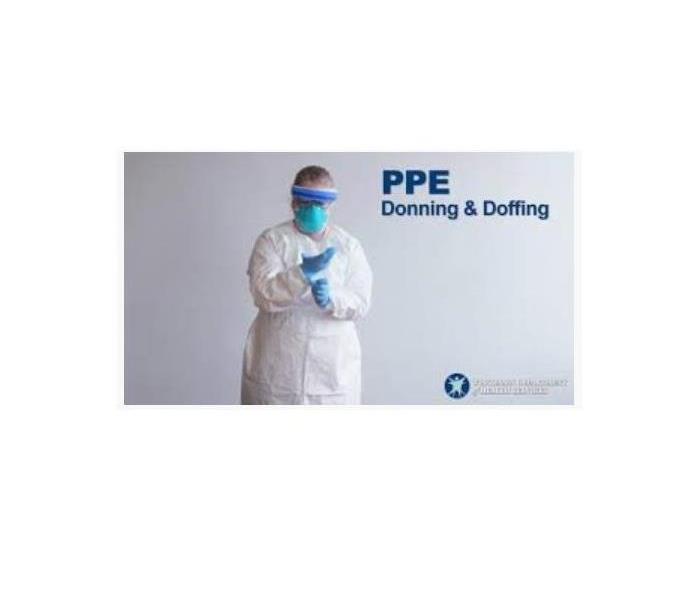SERVPRO's Use of Personal Protective Equipment
5/4/2020 (Permalink)
 Appropriate use of PPE keeps SERVPRO Technicians safe when performing Sanitizing and Cleaning.
Appropriate use of PPE keeps SERVPRO Technicians safe when performing Sanitizing and Cleaning.
In our line of work, SERVPRO® technicians come into contact with hazards that could cause injury and must use special personal protective equipment or PPE. Some examples of these hazards could be environments with dust, fumes, smoke or some that pose a biological or chemical threat if exposed and viruses. All technicians are trained in identifying when PPE is necessary on a jobsite, what and how to wear each item. It is also extremely important to understand the limitations of the personal protective equipment, useful life and proper disposal procedures.
On a CAT 3 site, you would see the following PPE on a SERVPRO® of West Riverside City technician:
Goggles: to protect technician’s eyes from hazardous materialsRespirator: to protect technician’s lungs from airborne contaminantsSuit/gloves: one-time use, disposable protective wear used to protect the technician’s skin from coming into contact with hazardous materialsCDC outlines how to DON and DOFF Personal Protective Equipment (PPE)
How to Put On (Don) PPE Gear
More than one donning method may be acceptable. Training and practice using your healthcare facility’s procedure is critical. Below is one example of donning.
Identify and gather the proper PPE to don. Ensure choice of gown size is correct (based on training).Perform hand hygiene using hand sanitizer.Put on isolation gown. Tie all of the ties on the gown. Assistance may be needed by other healthcare personnel.Put on NIOSH-approved N95 filtering facepiece respirator or higher (use a facemask if a respirator is not available). If the respirator has a nosepiece, it should be fitted to the nose with both hands, not bent or tented. Do not pinch the nosepiece with one hand. Respirator/facemask should be extended under chin. Both your mouth and nose should be protected. Do not wear respirator/facemask under your chin or store in scrubs pocket between patients.*Respirator: Respirator straps should be placed on crown of head (top strap) and base of neck (bottom strap). Perform a user seal check each time you put on the respirator.Facemask: Mask ties should be secured on crown of head (top tie) and base of neck (bottom tie). If mask has loops, hook them appropriately around your ears.Put on face shield or goggles. Face shields provide full face coverage. Goggles also provide excellent protection for eyes, but fogging is common.Perform hand hygiene before putting on gloves. Gloves should cover the cuff (wrist) of gown.Healthcare personnel may now enter patient room.How to Take Off (Doff) PPE Gear
More than one doffing method may be acceptable. Training and practice using your healthcare facility’s procedure is critical. Below is one example of doffing.
Remove gloves. Ensure glove removal does not cause additional contamination of hands. Gloves can be removed using more than one technique (e.g., glove-in-glove or bird beak).Remove gown. Untie all ties (or unsnap all buttons). Some gown ties can be broken rather than untied. Do so in gentle manner, avoiding a forceful movement. Reach up to the shoulders and carefully pull gown down and away from the body. Rolling the gown down is an acceptable approach. Dispose in trash receptacle. *Healthcare personnel may now exit patient room.Perform hand hygiene.Remove face shield or goggles. Carefully remove face shield or goggles by grabbing the strap and pulling upwards and away from head. Do not touch the front of face shield or goggles.Remove and discard respirator (or facemask if used instead of respirator). Do not touch the front of the respirator or facemask.*Respirator: Remove the bottom strap by touching only the strap and bring it carefully over the head. Grasp the top strap and bring it carefully over the head, and then pull the respirator away from the face without touching the front of the respirator.Facemask: Carefully untie (or unhook from the ears) and pull away from face without touching the front.Perform hand hygiene after removing the respirator/facemask and before putting it on again if your workplace is practicing reuse.** Facilities implementing reuse or extended use of PPE will need to adjust their donning and doffing procedures to accommodate those practices.






 24/7 Emergency Service
24/7 Emergency Service
